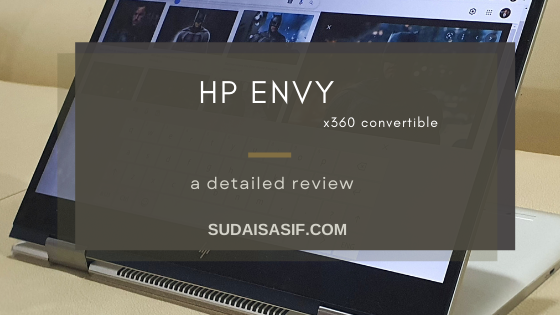Lately, I’ve been getting more interested in learning about computer hardware, everything from the specifications down to conducting actual benchmarks. And so to practice what I’ve been learning by skimming through many tech reviews, I decided to review my own current laptop, an HP ENVY x360 Convertible 15m-bp1xx. I got it in around May 2018 for Rs.80,000-85,000(I cannot recall the exact price) and have been using it since then. It was a certified refurbished device so nothing brand new but in 10/10 condition nonetheless.
To start, I’ll be dividing this review into multiple sections helping you evaluate different factors according to your preference.
Appearance & Features
Firstly, this is one beautiful laptop. The chassis(laptop case) is made up of Aluminium with a smooth touch giving a very elegant feel. The keys and touchpad too are arranged in a symmetrical manner – nothing that seems out of place to impart a blemish. To add to this, you have a backlit keyboard that looks pretty pretty at night-time. It can be activated using F5 along with other key features such as brightness, volume, and airplane mode also accessible through the function keys located at the top most row.
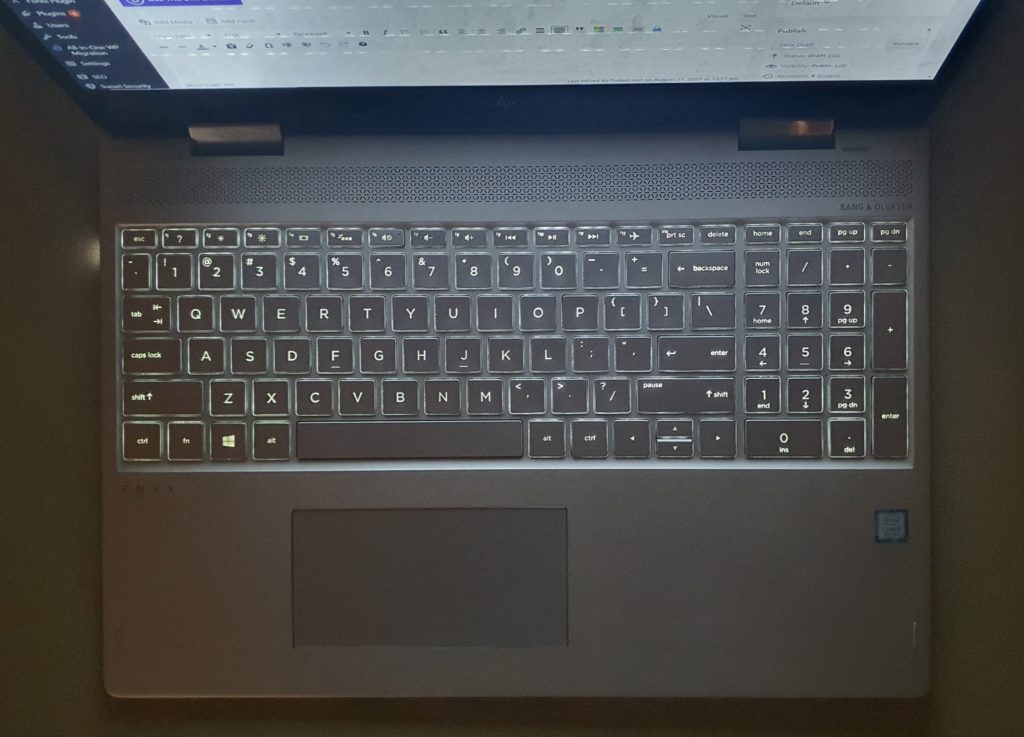
The keyboard is also high quality taking on a modern chiclet design and featuring media control keys as well. The key distance is not too much, not too less, just the perfect amount to give solid tactile feedback and ensure a high typing speed. Just so you know, I type a lot, less on some days perhaps ranging from 5000-35000 words depending on the week(courtesy of Grammarly Insights) and yet, the keyboard is working great as new.
The touchscreen works great as well with a fast response giving a smooth experience. On the convenience side, we have the following ports:
- HDMI on the left side
- USB 3.0 SuperSpeed on the left side
- Headphone Jack 3.5 mm on the left side
- Charging port on the right side
- USB 3.0 SuperSpeed on the right side
- Thunderbolt 3 USB on the right side
- SD card slot on the right side
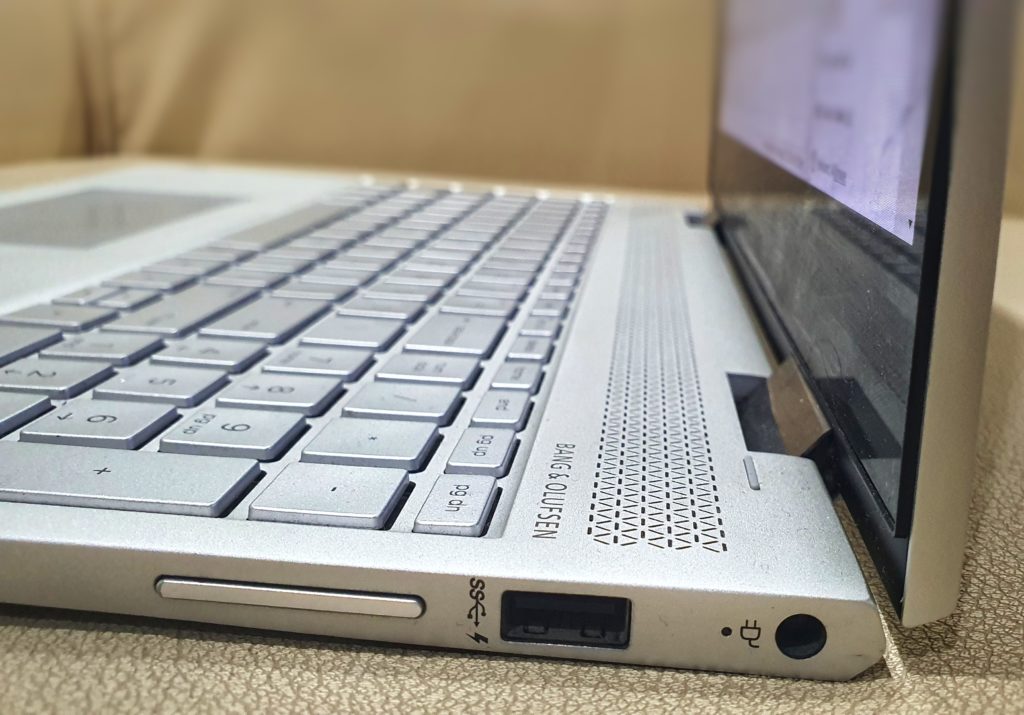
These have proved more than enough for me. Although I have to admit, I did not know the Thunderbolt port was “the port” that would support my Samsung charger cable and so I was using a USB 3.0 cable for a long time for data transfers – stupid me. On the other hand, there is no fingerprint reader but there is a built-in facial recognition feature. For business users who require advanced security protection, there isn’t any Kensington security lock port so you’ll have to look for another model.
The speakers’ panel is built just above the keyboard with Bang & Olufsen offering you high-quality audio than in HP’s lower-end models. You can also customize the settings for these using an already installed audio-control program. A cool feature amongst these is a multistreaming option offered which allows you to “listen to different audio sources” at the same time. For example, run a video on the native speakers and listen to music on a connected headphone at the same time.
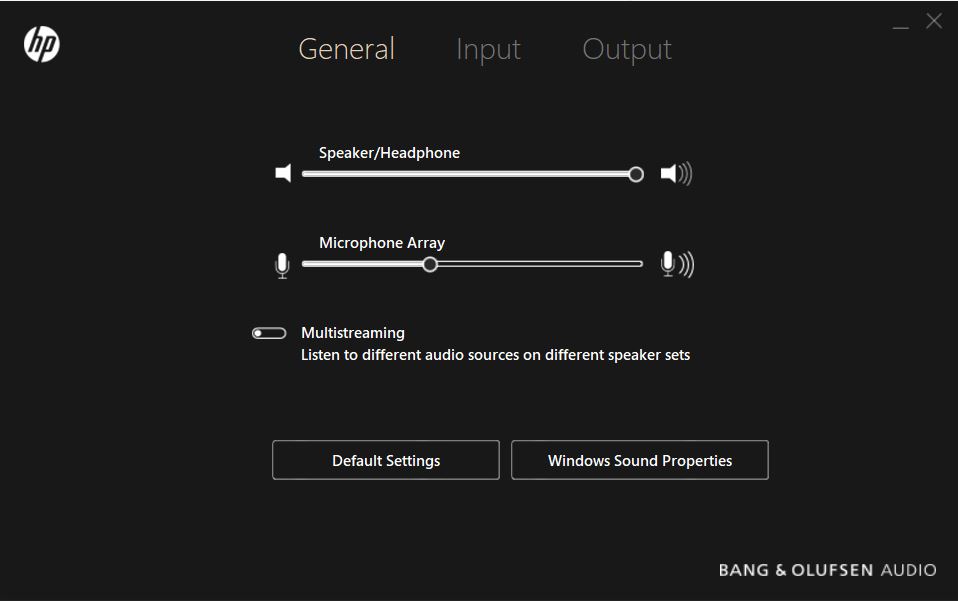
Coming to the screen, we have a large enough 15.6 inches display with a thin bezel on the left and right sides followed by a more thick one on the upper and downsides. The screen-to-body ratio is decent nonetheless and hasn’t proved to be unaesthetic in any sense. Personally, I really like the premium look it gives.
Convertibility
As the name of the laptop suggests, x360 means that it can be rotated 360 degrees and be used as both a tablet and a laptop.
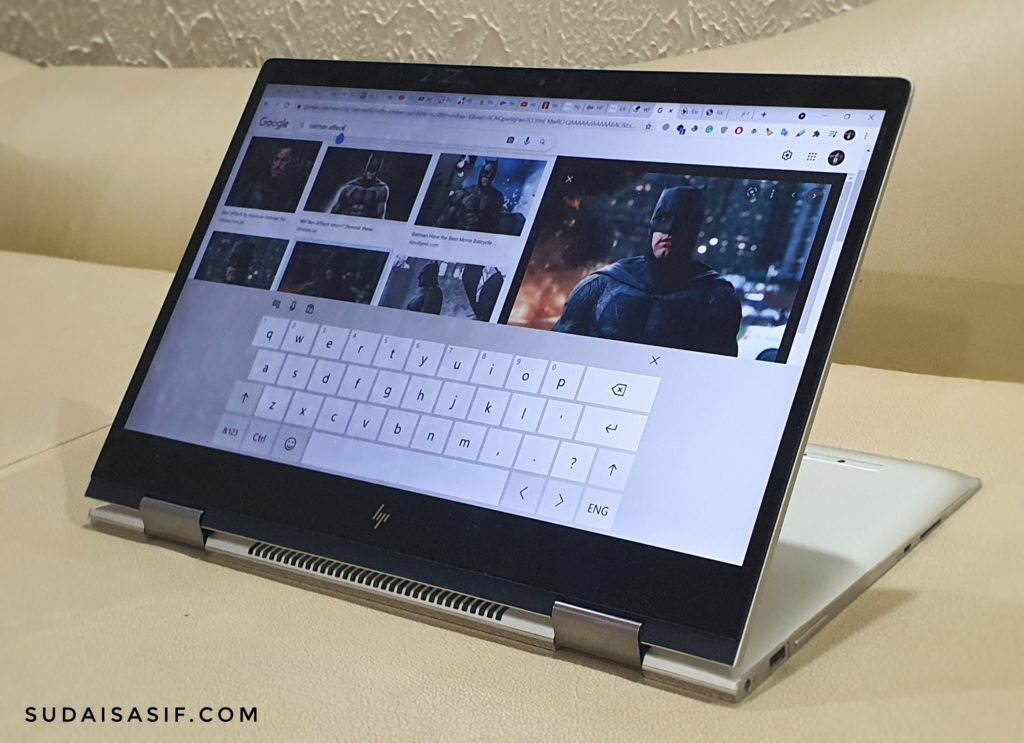
However, there’s a big disadvantage here. It weighs around 2.15 KG/4.74 lbs which means that the device seems too heavy for it to be easily used as a tablet. In fact, I would fear that the hinges would get damaged in this way and that’s nothing too precautionary. Many HP users have indeed reported broken hinges so you should definitely not go with this model if you plan to use it as a tablet. It is an added benefit but just that.
Performance
With 12 GB of RAM, an Intel i5 8th generation processor at 1.60 GHz, and 1 TB HDD storage, it runs pretty smoothly when doing multi-tasking involving programs like Google Chrome, window’s in-built video editor, playing music & videos, and general tasks. Since I use Google Docs/Sheets/Slides, I haven’t tested it with Microsoft Office but other Word Processing applications like Notepad work pretty well.
Boot-Up
Yet, it is important to remember that my laptop sports a 1 TB HDD which is great for storage but comes with a huge disadvantage. Compared to its SSD counterparts, an HDD is considerably slower and so when booting up my laptop from scratch, it can take more than 10 minutes sometimes. If the lappy is in a bad mood, expect to wait for 5 more for it to un-jam itself when Windows has finally loaded. I use mine’s almost all the time on a sleep-wake combo so this problem is more annoying if you’re a shut-down only person.
Window updates when they appear also take a lot of time so it’s best to leave them on overnight. However, sometimes I’ve found the machine to start getting stuck when an update is pending so that’s another disadvantage.
Photo and Video Editing
However, when it comes to heavy programs in the image editing & graphics design sphere, there is a bit of a lag that you can experience. In Adobe Illustrator, this was considerably less when I wasn’t applying any special effects. Yet, when working on multiple artboards with effects like Gaussian Blur applied to 5 or 6 of them, it did give me trouble. Adobe Photoshop was also not that fast although it runs well so you could get by easily with these 2 programs.
Now, when it comes to Adobe Premiere Pro, you really run into problems. To start with, my machine has Intel’s UHD 620 integrated graphics which means there is no dedicated GPU installed. Since Adobe Premiere Pro is a video editing application, you will hardly get it to run before freezing. And even if it does run, once I imported a video into it, the colors were all distorted due to an encoding engine incompatibility when that particular engine was using the laptop’s hardware. Now, I did change it to use the software for encoding but that just made it more slow so no luck. In a nutshell, you can apply specific effects to videos and get done with them but editing an entire video will be very difficult.
As for 3D software like Adobe Dimension, I was able to work on them but it was a slow experience. During the rendering phase, it also got stuck a lot of times so the experience ranks better than video editing but worse than photo editing.
I did not have any heating issues as far as I can remember.
Battery Life
To check out its battery life after more than 3 years of usage, I did a battery drain test where a video was played in VLC media player on loop with the volume at 20% and screen brightness at 100%. The Wi-Fi was also on to imitate real working conditions. The result wasn’t bad, it went from 100% to shut down in a solid 4 hours 16 minutes. Now, I know, this would be very less for those looking for a 6-7 hour usage but the fact is that this isn’t the battery in its prime condition. Moreover, since I was playing a video at 100% brightness, you can gain more hours of battery life by simply reducing the brightness(which I do not recommend, it becomes a bit dark for me).
Benchmarks
You see, to objectively compare different computers, we have something called benchmark tests which use the exact same criteria to evaluate every machine. This for example includes in-game benchmarks where a game would run for a set time doing the same tasks on 2 different machines and then give you statistics on how the 2 fared in respect to temperature rises, speed, frames per second, and other meaningful variables. Since this isn’t a gaming laptop by any respect, I ran a few benchmarks for measuring the laptop’s productivity.
Firstly, I ran Cinebench which measures the computer’s performance by getting it to generate high-quality images using both single-core and multi-core separately.
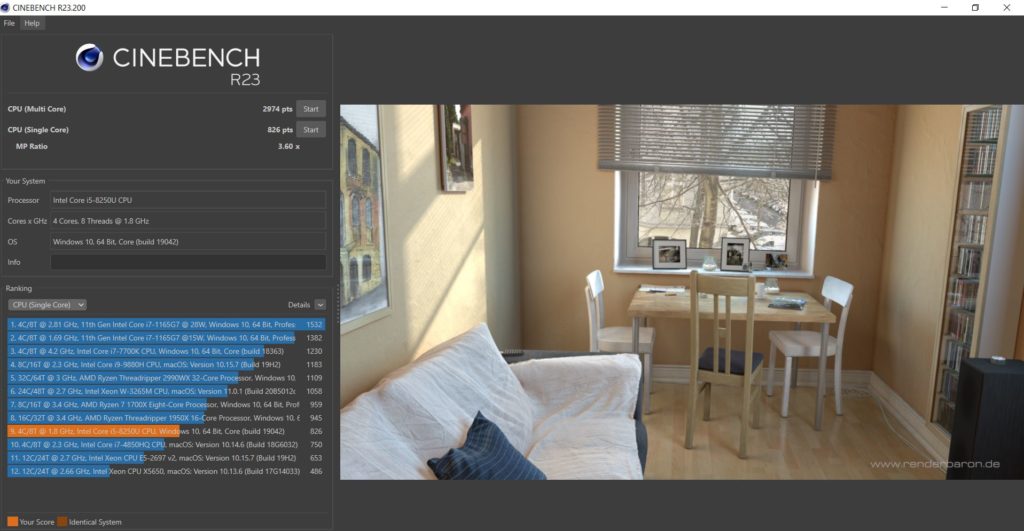
The colored bar on the very left indicates the score assigned to my CPU on single-core – 826 – which helps me compare it to the ranking of other systems whose specifications are given alongside. The benefit of this is that suppose you like 2 computers and are considering them as potential purchases. Beyond the specifications, you can learn how they will perform by comparing these benchmark scores with the higher number being the better. This is because every laptop or computer’s performance is dependent on a range of factors such as its cooling system and design rather than just the specifications.
For multi-core, it ranked even lower:
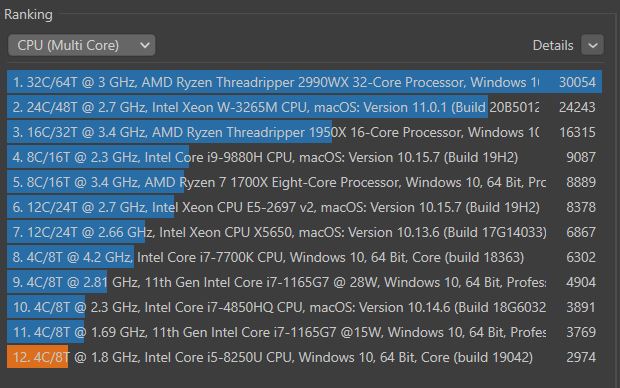
Next, I ran benchmark tests twice on GeekBench which is another popular program:
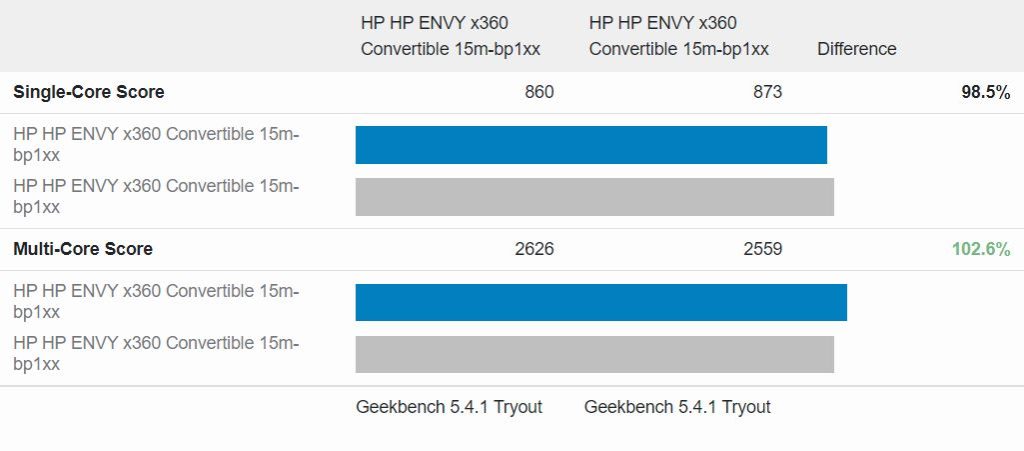
In some sub-tests, an increase or decrease was observed in the results but the overall scores remained the same offering a reasonable average. These metrics though are useful only for comparisons and not when considered in isolation. For practical usage, if you want to buy a laptop whose performance should be better than mine’s, simply google “laptop name, model and processor GeekBench score” and compare those numbers with mine. If your’s turn out higher, its going to be better performing. If not, you may want to look at another one. Alternatively, scores can also be found on the GeekBench website.
As a word of caution, if you need it for a very specific purpose, looking at the individual scores for each category help form a better picture. As an example for evaluating Machine Learning capabilities in multi-core:

Milk Resistant
Okay, it is not actually marketed as being milk resistant but I have a funny story. A few days ago, I spilled milk on the top of my keyboard. Luckily, I immediately wiped it off, shut down the laptop, and put it upside down for a long time to let all of it drain out. Later, I got it half disassembled and checked and there was no trace of any liquid. I did get lucky here but I would not recommend you to try it.
Conclusion
The HP Envy x360 is a decent laptop if your intended use revolves around web surfing, research work, or general business use. For photo editing and graphic design work, it can help you get started but it will lag in certain areas. On the other hand, for video editing, gaming or more complex applications, it definitely is a big no and you would be better off with a laptop offering a discrete GPU along with even more RAM in the 16-32 GB range.
If you like the looks, checking out the latest Envy and Spectre models may yield some really good potential purchases.

